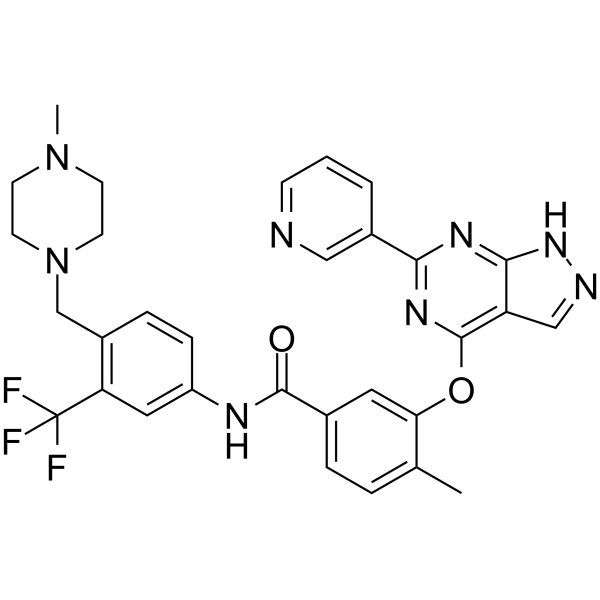| Description |
RET-IN-16 is a potent and selective RET inhibitor with IC50s of 3.98 nM, 8.42 nM, 15.05 nM, 7.86 nM, 5.43 nM and 8.86 nM for RET(WT), RET(M918T), RET(V804L), RET(V804M), RET-CCDC6 and RET-KIF5B, respectively. RET-IN-16 has anticancer effects[1].
|
| Related Catalog |
|
| Target |
IC50: 3.98 nM (RET(WT)), 8.42 nM (RET(M918T)), 15.05 nM (RET(V804L)), 7.86 nM (RET(V804M)), 5.43 nM (RET-CCDC6), 8.86 nM (RET-KIF5B)[1]
|
| In Vitro |
RET-IN-16 (compound 9x) (0.005-10 μM; 48 hours) exhibits potent activity against CCDC6-RET-Ba/F3 and KIF5B-RET-Ba/F3 with GI50 of 9 nM and 17 nM, respectively[1]. RET-IN-16 (1 μM; 48 hours) selectively suppresses the proliferation of CCDC6-RET fusion cells[1]. RET-IN-16 (50 and 100 μM; 4 hours) remarkably blocks the autophosphorylation of RET in KIF5B-RET and KIF5B-RETV804M Ba/F3 cells, and the phosphorylation of the adapter protein SHC is also inhibited with a dose-dependent manner[1]. Cell Proliferation Assay Cell Line: LC-2/ad, A549, H3122, MDA-MB-231 and A375, SKGT4, HepG2, KYSE450 and BGC823 cells[1] Concentration: 1 μM Incubation Time: 48 hours Result: Potently suppressed the proliferation of LC-2/ad NSCLC cells harboring the CCDC6-RET fusion, but dramatically decreased potency against other RET-negative cancer cells. Western Blot Analysis Cell Line: KIF5B-RET and KIF5B-RETV804M Ba/F3 cells[1] Concentration: 50 and 100 μM Incubation Time: 4 hours Result: Remarkably blocked the autophosphorylation of RET, and the phosphorylation of the adapter protein SHC was also inhibited in a dose-dependent manner.
|
| In Vivo |
RET-IN-16 (1 mg/kg; IV; single) exhibits a good drug exposure (AUC0-t = 6959 ± 762 ng·h/mL) and a moderate half-life (T1/2 = 4.28 ± 0.43 h)[1]. RET-IN-16 (10 mg/kg; PO; single) exhibits a low maximum plasma concentration (Cmax = 194 ± 47 ng·h/mL) and drug exposure (AUC0-t = 2112 ± 117 ng·h/mL)[1]. RET-IN-16 (30 and 50 mg/kg; IV; daily; for 8 days) suppresses tumor growth in a dose-dependent manner, and significantly suppresses p-RET and p-SHC in both KIF5B-RET and KIF5B-RETV804M in tumor tissues, as well as significantly induces apoptosis in vivo[1]. Pharmacokinetic Parameters of RET-IN-16 in male Sprague-Dawley rats[1]. IV (1 mg/kg) PO (10 mg/kg) T1/2 (h) 4.28 ± 0.43 7.59 ± 1.02 Tmax (h) 0.083 ± 0 0.75 ± 0.43 Cmax (ng/mL) 6097 ± 623 194 ± 47 AUC0-t (ng/mL·h) 6959 ± 762 2112 ± 117 AUC0-∞ (ng/mL·h) 7014 ± 753 2343 ± 157 F (%) 3.0 Animal Model: Male Sprague-Dawley rats[1] Dosage: 1 mg/kg for IV, 10 mg/kg for PO Administration: IV and PO; single (Pharmacokinetic Analysis) Result: Exhibited a good drug exposure (AUC0-t = 6959 ± 762 ng·h/mL) and a moderate half-life (T1/2 = 4.28 ± 0.43 h) at 1 mg/kg IV; observed a low maximum plasma concentration (Cmax = 194 ± 47 ng·h/mL) and drug exposure (AUC0-t = 2112 ± 117 ng·h/mL) at 10 mg/kg PO. Animal Model: Half male and female BALB/c-nu mice (6-8 weeks; injected with KIF5B-RET Ba/F3 and KIF5B-RETV804M Ba/F3)[1] Dosage: 30 and 50 mg/kg Administration: IV; daily; for 8 days Result: Suppressed tumor growth in a dose-dependent manner, and significantly suppressed p-RET and p-SHC in both KIF5B-RET and KIF5B-RETV804M in tumor tissues, as well as significantly induced apoptosis in vivo.
|
| References |
[1]. Li X, Su J, Yang Y, et al. Discovery of 4-methyl-N-(4-((4-methylpiperazin- 1-yl)methyl)-3-(trifluoromethyl)phenyl)-3-((6-(pyridin-3-yl)-1H-pyrazolo[3,4-d]pyrimidin-4-yl)-oxy)benzamide as a potent inhibitor of RET and its gatekeeper mutant. Eur J Med Chem. 2020;207:112755.
|
